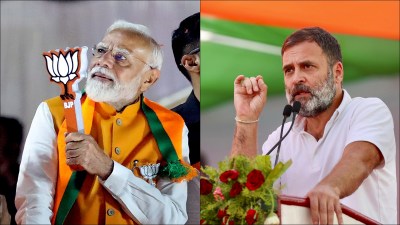- India
- International
Copy Capital: Spotlight back on organised copying in UP
The suicide by a student and a bid by another to kill himself have put the spotlight back on organised copying in UP.
 A high school or intermediate certificate in some parts of U.P. costs anywhere between Rs 1,500 and Rs 15,000, sometimes even more. ( Photo: Vishal Srivastav)
A high school or intermediate certificate in some parts of U.P. costs anywhere between Rs 1,500 and Rs 15,000, sometimes even more. ( Photo: Vishal Srivastav)
By: Hamza Khan
March 9, Firozabad: Akash, 17, son of an autorickshaw driver, set himself on fire. His family had been unable to raise an extra Rs 3,000 that his school principal had allegedly demanded to let him copy answers during his Class X Board examination. His parents had reportedly paid Rs 4,000, but that wasn’t enough. Akash died the next day.
March 10, Kaushambi: Akshay Sonkar, 18, son of a farmer, had allegedly paid his principal Rs 2,000 to let him copy in his Class XII Boards. The principal reportedly wanted Rs 5,000 more and the family couldn’t afford it. Akshay consumed poison, but luckily survived.
March 23, Ballia: Villagers in Saraibharati village clashed with policemen outside a college, alleging extortion during an examination. Nine policemen, including a Deputy Superintendent of Police, were injured and 40 villagers arrested. Residents alleged that a student, Nandini Sharma, wasn’t allowed to appear for her exam and that her brother Shashikant, who had gone to inquire, was beaten up.
This year, 71,20,265 students registered themselves for their Class X and XII UP Board examinations, 6.74 lakh more than last year. The examination is a milestone they better not skip, but there is an easier, institutionalised way round it — mass copying. But as Akash and Akshay were to find out, that comes at a price. Often, it is the school manager or principal who sets the price, coaxing the families for the maximum money he or she can extract.

Unfair practices during exams are a thriving business in some parts of Uttar Pradesh, especially the eastern districts of Kaushambi, Azamgarh, Ballia and parts of the Samajwadi Party’s home turf, including Etah and Mainpuri. A high school or intermediate certificate in these parts costs anywhere between Rs 1,500 and Rs 15,000, sometimes even more.
Among the four categories of schools — government, government-aided, government-unaided and unrecognised private or ‘fake’ — the last two are almost always at the heart of the racket. “These unrecognised schools, which operate out of single rooms or even rooftops, enroll students assuring them they can clear their examinations without much trouble,” says Prakhar Yadav, who runs a college in Mainpuri. “As exams approach, these schools enroll students in recognised schools in connivance with authorities, thus bringing them into the system.”
In July 2012, R P Mishra, president of the Uttar Pradesh Madhyamik Shikshak Sangh, who has been campaigning against irregularities in the education department, submitted a list of 351 ‘fake schools’ in Lucknow alone. Umesh Tripathi, then District Inspector of Schools (DIOS), Lucknow, cracked down on these schools and registered FIRs against 229 of them. But, Mishra alleges, the administration then gave in to political pressure and the issue fizzled out.
The ‘process’ begins at the time of registration, when a student from one of these fake schools is enrolled into a recognised school. As per rules, a student appearing for his Class X Board exam has to be registered in a school the previous year, in Class IX. Similarly, a student appearing for his Class XII Board exam should have been registered in Class XI the previous year. “Schools delay the registration process and, in some cases, both the registration and the Board examination forms are filled up simultaneously. Some schools take money in instalments, others want a lump sum at the time of registration,” says Mishra.
Students get themselves enrolled in multiple schools, just to be on the safer side. The managers of these schools usually seek ‘favourable’ examination centres near their institutions and get them without much trouble. This year, for instance, citing a shortage of examination centres, the administration registered even those centres which were blacklisted last year over corruption charges. Mishra alleges that schools pay Rs 50,000 to a few lakhs to the DIOS to get a centre of their choice.
Secretary, Secondary Education, Shakuntala Yadav, dismisses these charges. “Our job is to conduct examinations and ensure there are enough centres where they can be held. These allegations are levelled by schools which weren’t selected as centres. If they are convinced of foul play, why don’t they get FIRs registered against the DIOS?”
After the examination centre is allotted, schools try their best to get their teachers appointed as invigilators at these centres. The rule is that subject teachers cannot invigilate an exam of that subject. Yet, there have been several instances of flying squads catching subject teachers during invigilation. A common excuse in this case is lack of staff.
DIOS P C Yadav says subject teachers assisting students — an indication of organised copying — is a problem in Lucknow too. “We keep coming across subject teachers helping students during exams. Notices are issued to all such centres and action is taken,” says Yadav.
Finally, when the exams begin, students can ‘buy’ the category of copying that suits their pockets. Depending on the money they shell out, students are segregated into three categories and allotted rooms accordingly. Explained school managers, speaking on the condition of anonymity: Category one, which costs the least, comprises students who are allowed to use their own material for copying. Category two students are dictated answers or can copy them from the blackboard. Category three students don’t have to appear for examinations and an impersonator, usually a subject teacher, is arranged for them.
This, in turn, means that teachers running coaching centres are in high demand. Asit Yadav, who runs a coaching centre in Mainpuri, says that a coaching centre teacher can impersonate a student and earn Rs 5,000 to Rs 20,000 per paper.
“Schools are judged by their pass percentage. Parents and students prefer schools that assure them that examinations will be cleared with minimum hassle. Trying to prevent copying hampers this business,” he adds.
Baba Har Narayan runs three schools in Etawah. Three years ago, he clamped down on mass copying in his schools and, ever since, the number of students in his school has been constantly declining.
The DIOS sends flying squads to conduct random checks at centres. On the first day of this year’s Board exams, a flying squad in Bareilly caught the staff of an exam centre dictating and writing answers on blackboards. An FIR was registered against the centre’s superintendent. But the flying squads haven’t been much of a deterrent. Ramvir Singh Yadav, an SP leader in Kisni block of Mainpuri, says some centres even put up cameras to look out for these squads.
Baba Har Narayan says some schools employ “dummy flying squads” to extort money. “The members of such ‘squads’ are usually friends of the principal or manager. They randomly swoop down on candidates and threaten them,” he says. The principal then pretends to intervene on the student’s behalf and, after the squad leaves, demands money from the student.
For the students, it doesn’t pay to be upright, especially at centres with organised copying. Anil Singh, a BA student in Mainpuri, says he found that out the hard way. “My friend and I appeared for our intermediate examinations (Class XII) a couple of years ago. I used to study all day while he would while away his time. During examinations, he paid to copy while I was sure my hard work would see me through. But I failed and he cleared with first division,” he says.
“Students who refuse to pay are discriminated against. Some schools make them sit outside on the grounds, making them outcasts of sorts. While in some other centres, it doesn’t matter if you want to copy or not, you have to pay up a certain amount if you want to appear for the exam,” says Asit of the Mainpuri coaching centre. Asit says parents are tired of the “copying mafia”, but only because they find the ‘rates’ prohibitive. “Some parents approached me and I proposed that we should start a campaign — prepare a banner saying ‘Naqal mafia ke virodh mein (against copying mafia)’ — protest against such examination centres and invite journalists. But the parents declined. They just wanted the school managers to reduce rates, nothing more,” says Asit.
There have been attempts to deal with copying in the past. In 1992, Rajnath Singh, as education minister in the Kalyan Singh government, introduced the Anti-Copying Act, making copying a cognisable, non-bailable offence. That year, UP Board’s Class X pass percentage came down from 58.03 in 1991 to 14.70; figures for intermediate came down to 30.38 per cent from 80.54 the previous year.
With many students being sent to jail for copying, the Samajwadi Party made it a poll issue before Mulayam Singh Yadav took over as chief minister in December 1993. The Act was later reintroduced and the offence made bailable. The pass percentage for Class X crossed 50 in 1995. Between 1998 and 2002, pass percentages dropped again. In 2004, with the SP government back in the saddle, Mulayam came up with the ‘self-centre scheme’, ending the rule that students have to sit for Board examinations in centres other than their schools. The pass percentage for Class X jumped to 70.61 per cent.
However, Vasudev Yadav, then secretary of Secondary Education Board, defends the scheme, saying that it helped students concentrate on studies without having to travel to other centres.
Criticising the SP government, BJP’s state spokesperson Chandra Mohan says, “It was under the SP patronage that the copying mafia found its feet.”
Meanwhile, as another examination season draws to a close, Education Secretary Shakuntala Yadav claims that around 1,500 students have been caught copying and about 50 FIRs registered this year. But given that over 70 lakh students sat for the exams this year, 50 FIRs may end up as a mild statistic — just for the record.
Apr 25: Latest News
- 01
- 02
- 03
- 04
- 05








































